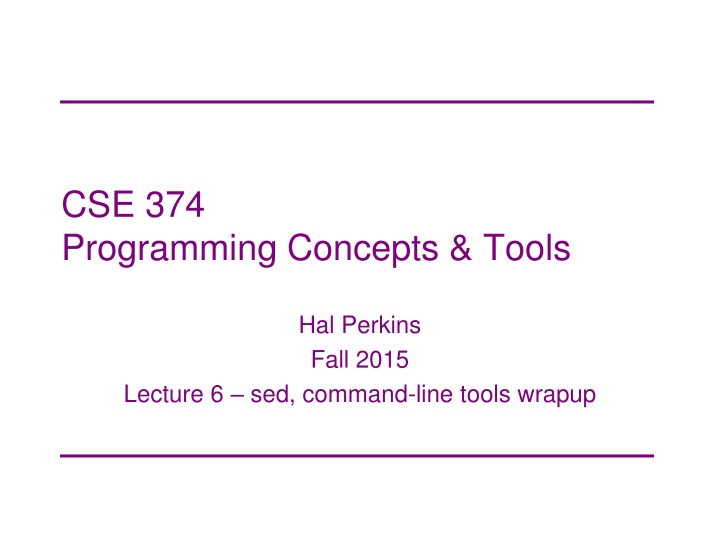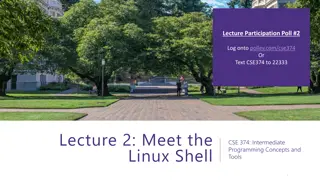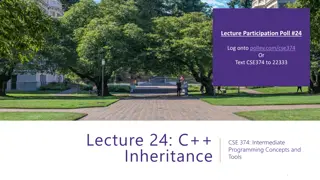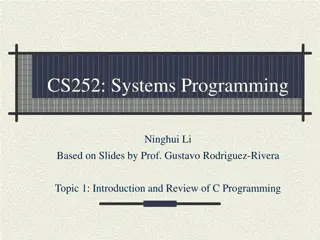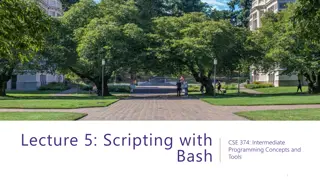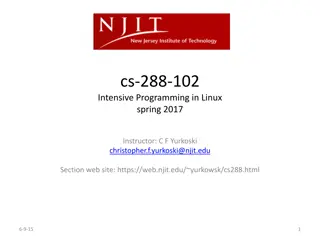CSE 374 Programming Concepts & Tools
In this lecture, Hal Perkins summarizes key programming concepts and tools, focusing on sed commands and command-line tools. Learn how these tools can enhance your programming skills and increase efficiency in text processing tasks. Gain practical insights on using sed and command-line tools effectively for efficient code manipulation and text processing, rounding up your understanding of essential programming techniques.
Download Presentation

Please find below an Image/Link to download the presentation.
The content on the website is provided AS IS for your information and personal use only. It may not be sold, licensed, or shared on other websites without obtaining consent from the author.If you encounter any issues during the download, it is possible that the publisher has removed the file from their server.
You are allowed to download the files provided on this website for personal or commercial use, subject to the condition that they are used lawfully. All files are the property of their respective owners.
The content on the website is provided AS IS for your information and personal use only. It may not be sold, licensed, or shared on other websites without obtaining consent from the author.
E N D
Presentation Transcript
CSE 374 Programming Concepts & Tools Hal Perkins Fall 2015 Lecture 6 sed, command-line tools wrapup
Where we are Learned how to use the shell to run, combine, and write programs Learned regular-expressions (plus more) and grep for finding guided by regexps Now: sed for find-and-replace guided by regexps Then: Short plug for awk (not tested or taught) Then: Introduction to C 2
Review grep takes a pattern and a file (or stdin) The pattern describes a regexp: Example: a[bc]*.?.?d*e Special characters: . ? ^ $ * ( ) [ ] + { } \ | (Some need escaping; see the man page) grep prints any line that has one or more substrings that match. Or invert with -v Or count with -c So the output is basically a subset of the input. What if we want to change or add some output? Enter sed 3
sed A stream editor; a terrible little language that processes one line at a time. Multi-line manipulations possible but painful. Simple most-common use (and -e optional here): sed -e s/pattern/replacement/g file For each line in file, replace every (longest) substring that matches pattern with replacement and then print it to standard out. (often want to quote s/ / /g to avoid shell substitutions) Simple variations: omit file: read from stdin omit g: replace only first match sed -n and add p where g is: print only lines with 1 match multiple -e s/.../.../...: apply each left-to-right -f file2: read script from file; apply each line top-to-bottom 4
More sed The replacement text can use \1 . . . \9 very common. Hint: To avoid printing the whole line, match the whole line and then have the replacement print only the part you want. Newline note: The \n is not in the text matched against and is (re)-added when printed. i.e., lines are read into an edit buffer and processed there without the (local system s) newline. Aside: Line-ending madness on 3 common operating systems. 5
Even more sed sed lines can have more: different commands (so far, s for substitution) A couple others: p, d, N Other useful ones use the hold space (next slide) different addresses (before the command) number for exactly that line number first~step (GNU only) (lines are first + n*step) $ last line /regexp/ lines containing a match of regexp a label such as :foo before address or command [:label] [address] [command-letter][more-stuff-for-command] 6
Fancy stuff Usually (but not always) when you get to this stuff, your script is unreadable and easier to write in another language. The hold space. One other string that is held across lines. Also the pattern space (where the current line starts). x, G, H Branches to labels (b and t) Enough to code up conditionals and loops like in assembly language. Your instructor never remembers the details, but knows roughly what is possible. 7
sed summary The simplest way to do simple find-and-replace using regexps. Standard on all Linux/Unix systems, even in limited recovery boot modes Programs longer than a few lines are possible, but probably the wrong tool. But a line-oriented stream editor is a very common need, and learning how to use one can help you use a better one. In homework 3, a one-liner is plenty. For the rest, see the manual. 8
awk We will skip awk, another useful line-oriented editor. Compared to sed: Much saner programming constructs (math, variables, for-loops, . . . ) Easier to print fields of lines, where fields are separated by a chosen delimiter Easier to process multiple lines at a time (change the end-of-line delimiter) Less regexp support; one-liners not as short 9
String-processing symmary Many modern scripting languages (perl, python, ruby, et al) support grep, sed, and awk features directly in the language, perhaps with better syntax. Better: combine features Worse: one big program that hopefully has everything instead of useful small ones When all you need to do is simple text manipulation, these tools let you hack something up quicker than, say, Java. But if you need real data structures, performance, libraries, etc., you reach their practical limits quickly. 10
